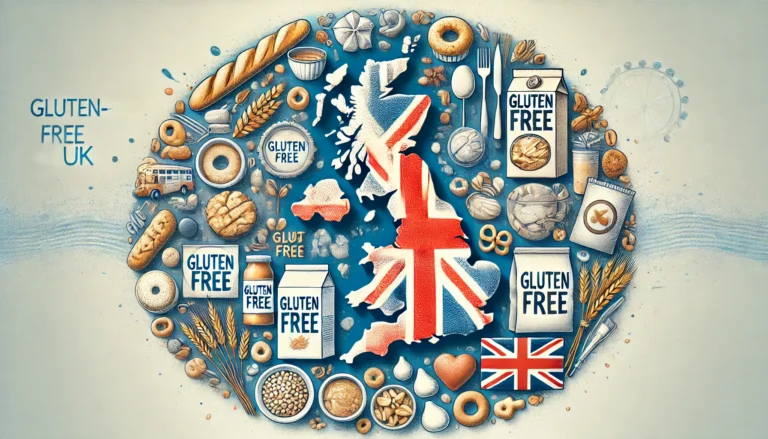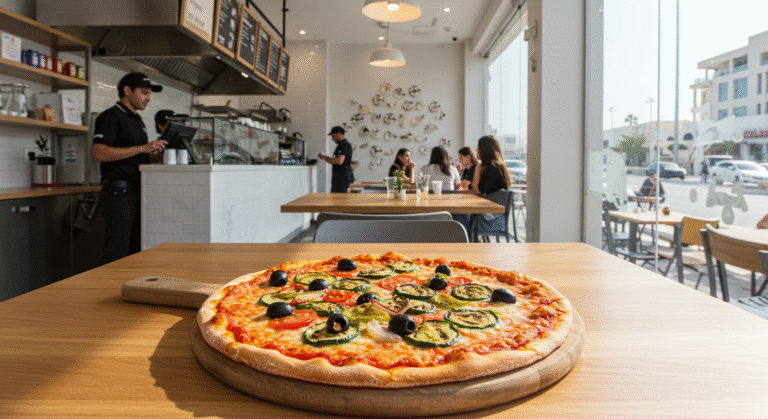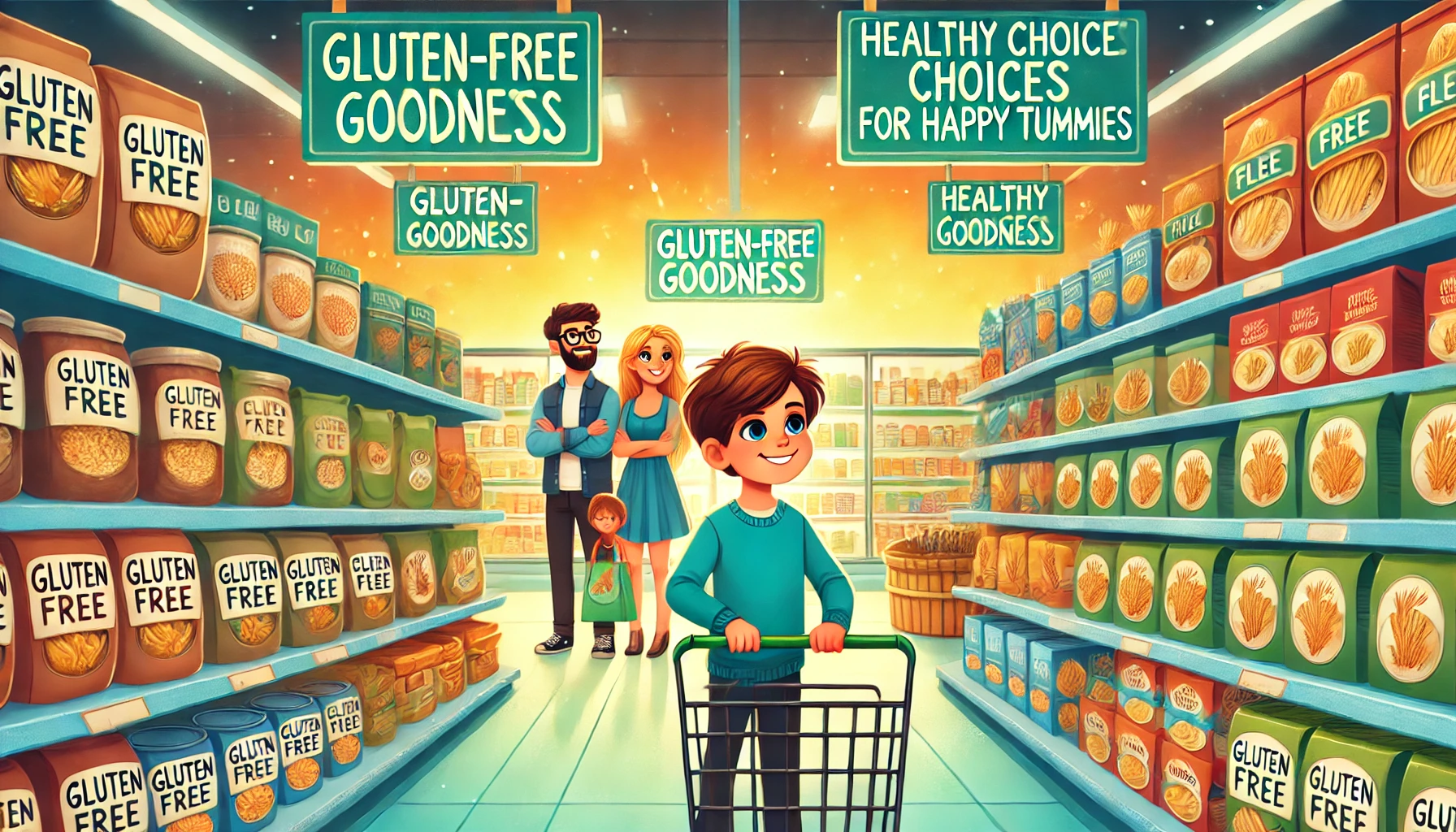
Hey there, gluten-free gang! It’s me, Ari, your friendly 8-year-old gluten-free blogger. Today, we’re talking about something super important but not too scary – gluten intolerance. You know that feeling when you eat something and your tummy goes, “Whoa, hold up, I don’t like this!”? That could be gluten intolerance. Now, I know it sounds a bit technical, but I’m here to make it fun and easy to understand. So, let’s get into the nitty-gritty of what gluten intolerance really is and how it can affect you.
First off, what’s this gluten thing everyone’s talking about? It’s a protein found in delicious foods like bread, pasta, and cakes. But, for some of us, gluten is like that annoying mosquito that just won’t leave you alone! Our bodies start acting up, and we end up feeling pretty yucky. This doesn’t mean we have coeliac disease, which is more serious, but we still need to be careful.
Gluten Intolerance Symptoms
In this blog, we’ll chat about the common signs of gluten intolerance like tummy aches, tiredness, and even brain fog. Don’t worry – I’ll keep it light, fun, and informative. Plus, I’ll share some tips on living happily without gluten, because trust me, there are still loads of yummy things to eat. Ready to dive in? Let’s go!
What’s Gluten Anyway?
First things first – what exactly is gluten? Well, gluten is a sticky protein found in wheat, barley, and rye. Imagine it as the glue that holds your favourite bread and pasta together. It’s what gives them that lovely, chewy texture. But for some of us, this glue can be a bit of a troublemaker. When we eat foods with gluten, our bodies might react in ways that make us feel not-so-great.
Gluten intolerance, also known as non-coeliac gluten sensitivity (NCGS), is when your body doesn’t have a fun time processing gluten. You might get symptoms like stomach pain, headaches, or tiredness. It’s like your body is throwing a mini tantrum, saying,
“I don’t want this gluten stuff!”
Unlike coeliac disease, which can harm your insides, gluten intolerance doesn’t cause any permanent damage. But it can still make you feel pretty lousy.
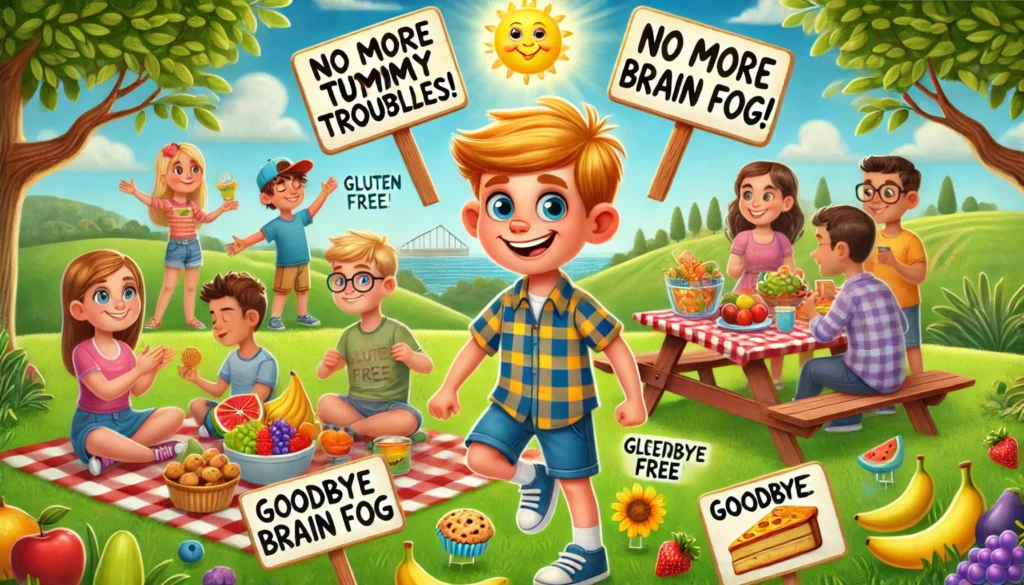
The tricky thing is, gluten is hiding in lots of foods – not just bread and pasta. It can sneak into sauces, soups, and even some sweets. So, it’s important to keep an eye on what you’re eating if you think gluten might be bothering you. But don’t worry! There are loads of delicious gluten-free options out there. You can still enjoy your favourite meals without the gluten trouble!
The Tummy Troubles
Now let’s talk about the biggest sign of gluten intolerance – tummy troubles! Imagine you’ve just had a tasty sandwich or a big bowl of pasta, and then, bam! Your belly feels like it’s filled with air, like you’ve swallowed a balloon. This is called bloating. It can make you feel super uncomfortable, like you need to unbutton your jeans just to breathe. Along with bloating, you might get stomach cramps that make you want to curl up in a ball. Not fun, right?
Sometimes, your tummy troubles can mess with your trips to the loo too. You might find yourself going more often (hello, diarrhoea!) or not at all (uh-oh, constipation!). It’s like your tummy is playing tricks on you. And it’s not just about the bathroom – you might feel nauseous, like you’re going to throw up, or even get heartburn, which feels like your chest is on fire.
If you’ve been feeling like this after eating foods like bread, pizza, or biscuits, it might be your body’s way of saying, “Hey, I’m not a fan of gluten!” It’s super important to talk to your parents or a grown-up about it. They can help you figure out what’s going on and maybe even take you to see a doctor who can check things out. Check out this Healthlinearticle for more info on why your tummy might be upset.
Feeling Super Tired – What’s Up with That?
Ever feel like you’re walking around with your eyes half-closed, even though you’ve had a good night’s sleep? That’s called fatigue, and it’s another sign of gluten intolerance. It’s like your body is using all its energy just to deal with the gluten, leaving you feeling drained and exhausted. Imagine trying to play your favourite game with only half your energy bar – that’s what fatigue feels like!
This kind of tiredness can make it hard to do the things you love. You might feel too sleepy to hang out with your friends, play your favourite sports, or even concentrate in class. It’s like your brain is in slow-motion mode, making everything feel harder than it should be. And it’s not just about wanting to take a nap – your whole body might feel heavy and sluggish, like you’re trying to walk through mud.
If you notice that you’re feeling super tired all the time, especially after eating certain foods, it could be a sign that gluten isn’t agreeing with you. It’s a good idea to chat with your parents or a teacher about it. They can help you figure out if gluten is the problem and find ways to keep your energy levels up. For more on gluten and tiredness, head over to the Celiac Disease Foundation website.
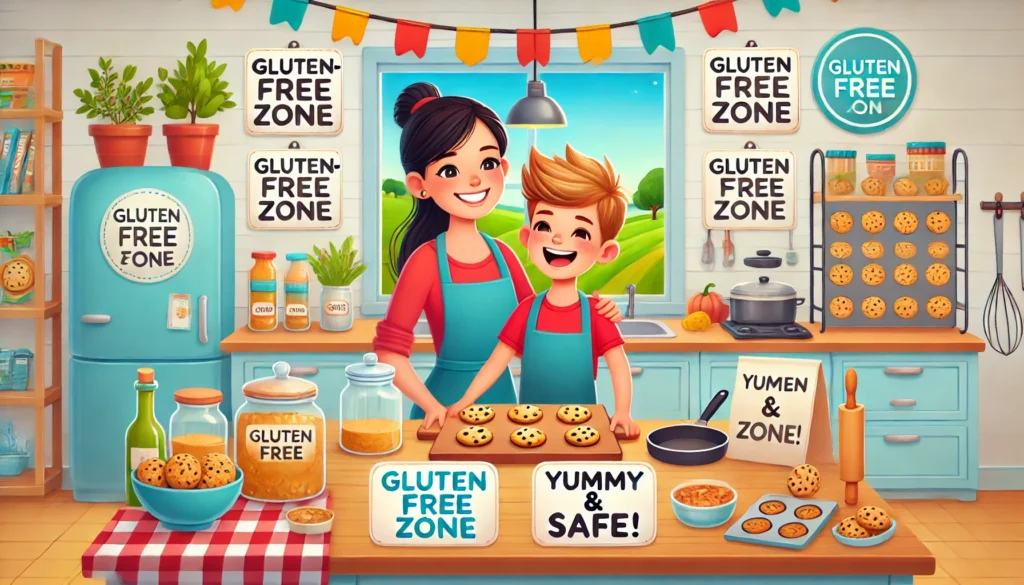
Headaches from Gluten – Ouch!
Let’s talk headaches – and not just any headaches, but the kind that make you feel like your head is being squeezed by a giant octopus! These headaches can be pretty intense, and they’re another sign that your body might not be a fan of gluten. You might feel pain all over your head or just in certain spots like your forehead. It’s like your head is trying to send you a message: “Something’s not right here!”
Sometimes, these headaches come with other not-so-fun symptoms, like feeling dizzy or lightheaded. You might even find that bright lights and loud noises make the pain worse. It’s like your senses are on high alert, making everything feel more annoying than usual.
If you start getting headaches a lot, especially after eating, it’s really important to tell your parents or a teacher. They can help you figure out if it might be because of gluten or something else. Keeping a diary of when these headaches happen and what you ate can be super helpful. Want to know more about gluten headaches? Bupa’s got the scoop.
Itchy, Scratchy Skin – When Gluten Bothers Your Body Outside
Did you know that gluten can mess with your skin too? Yep, it’s not just your tummy that can get upset. Some people with gluten intolerance get rashes, bumps, or itchy skin. It’s like your skin is saying, “Hey, I don’t like that gluten stuff!” One specific kind of skin issue is called dermatitis herpetiformis. That’s a big name for a rash that can be super itchy and uncomfortable.
This rash usually shows up on places like your elbows, knees, or even your bottom (yikes!). It might look like little red bumps or blisters, and it can be really hard to resist the urge to scratch. Scratching can make it worse though, so try to keep your hands off! If you notice a rash like this after eating foods with gluten, it’s time to chat with a grown-up and maybe see a doctor.
There are plenty of yummy gluten-free foods that won’t make your skin act up. So, don’t worry! You can still enjoy lots of delicious meals without dealing with itchy skin. It’s just a matter of finding out what works best for you and sticking to it.

Brain Fog – When Thinking Gets Fuzzy
Ever feel like your brain is moving through a thick fog, making it hard to think straight? That’s called brain fog, and it can be another sign of gluten intolerance. It’s like trying to solve a puzzle when you can’t see all the pieces – frustrating, right? You might find it tough to concentrate, remember things, or even find the right words when you’re talking.
Brain fog can make schoolwork feel impossible. It’s like your brain is moving in slow motion, making even simple tasks take forever. You might find yourself daydreaming or staring off into space without realising it. And it’s not because you’re not trying – it’s just that your brain isn’t working at full speed.
If you’ve been experiencing brain fog, especially after eating certain foods, it could be a sign that gluten is the problem. Talk to your parents or teachers about it. They can help you figure out what’s going on and maybe even suggest some changes to your diet that could help clear things up. Learn more about brain fog and gluten here.
Ouch, My Joints! When Moving Hurts
For some people with gluten intolerance, their joints – like knees, elbows, or even fingers – might start to ache. It’s like your body is saying,
“Hey, I don’t like this gluten stuff!”
This pain can make it tough to do the things you love, like playing sports or running around with your friends. It’s no fun feeling like you’ve aged a hundred years after just a slice of pizza!
Joint pain from gluten intolerance can feel different for everyone. Some people might feel a dull ache, while others might feel sharp pain or stiffness. It can be hard to bend or stretch certain parts of your body. And the pain can move around too – one day it might be your knees, and the next it could be your fingers. It’s like a game of ‘chase the pain’ that no one wants to play.
If you notice that your joints hurt, especially after eating foods with gluten, it’s super important to tell a grown-up. They can help you figure out if gluten is the cause and what you can do to feel better. It’s always okay to speak up when something doesn’t feel right!
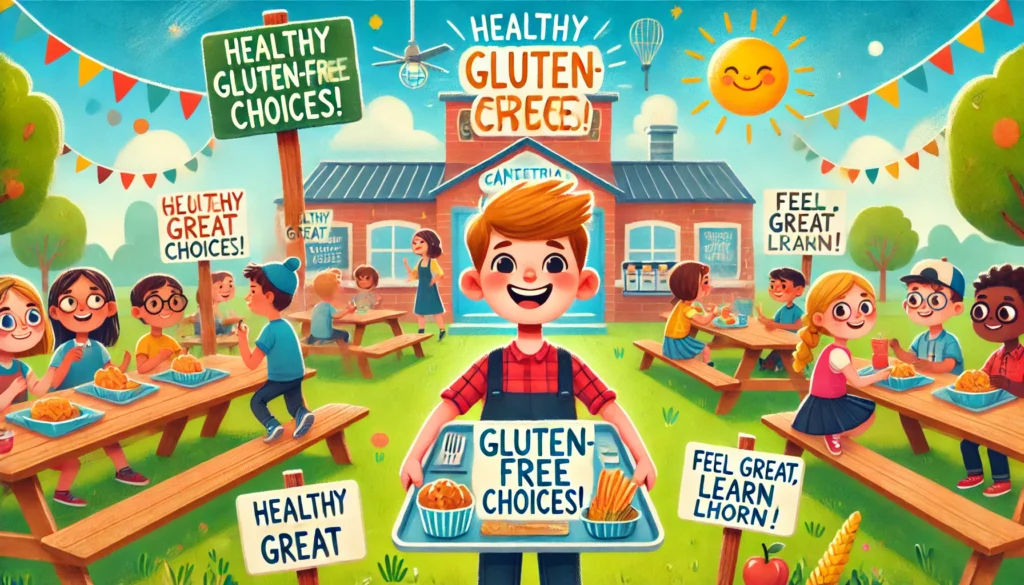
What to Do If You Think You Have Gluten Intolerance
If you think gluten might be making you feel yucky, the first step is to talk to your parents or a grown-up you trust. Tell them how you’ve been feeling, especially if you notice you feel bad after eating certain foods. They can help you keep track of what you eat and how you feel.
The next step might be visiting a doctor. Don’t worry, doctors are there to help you feel better! They might ask you lots of questions about how you feel and what you eat. They might also do some tests to figure out if gluten is really the problem.
One thing the doctor might suggest is trying a gluten-free diet for a while to see if you feel better. This means not eating foods with gluten in them for a few weeks or months. It’s important to do this with help from a doctor or a dietitian (that’s a food expert) to make sure you’re still eating all the good foods your body needs to grow and be healthy.
Yummy Gluten-Free Foods to Try
No gluten? No problem! There are loads of delicious things to eat, like gluten-free bread, pasta, and even cookies. You can also munch on naturally gluten-free foods like fruits, veggies, nuts, and popcorn. It’s a great way to explore new flavours and foods.
You can also find awesome gluten-free options at places like Pizza Express and Schar gluten-free bread. It’s an adventure in every bite!

Living Happily Without Gluten
Living gluten-free might seem tricky at first, but it’s totally doable. You’ll still be able to have fun with friends, go to parties, and enjoy yummy food. With a little planning and some tasty gluten-free snacks, you can do anything!
Remember, if something feels off, always talk to a grown-up. They’re there to help you feel your best. And who knows? You might even discover your new favourite food along the way!

